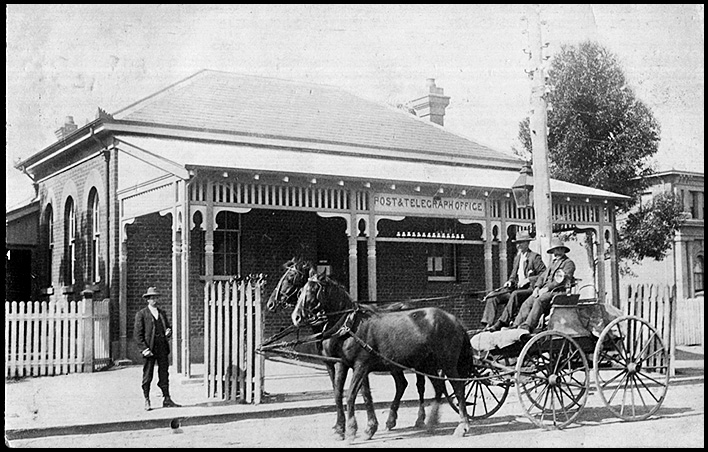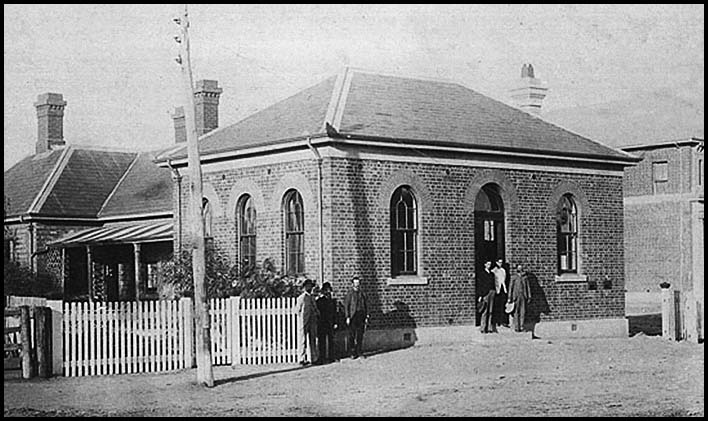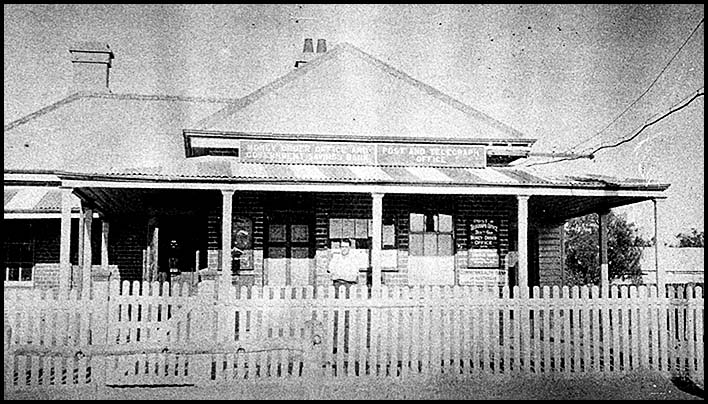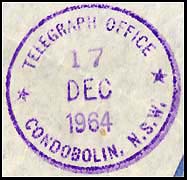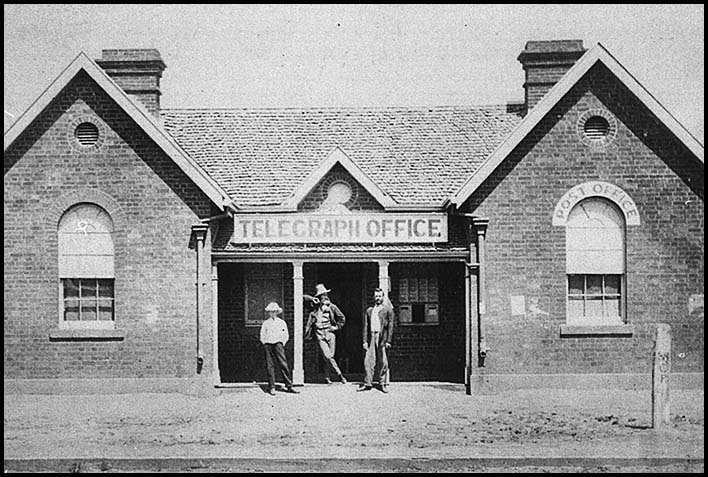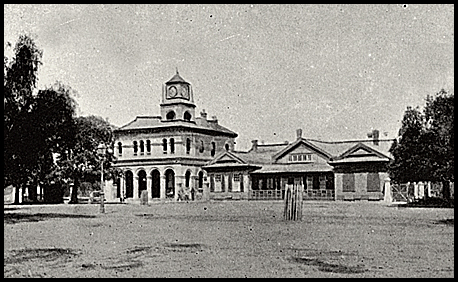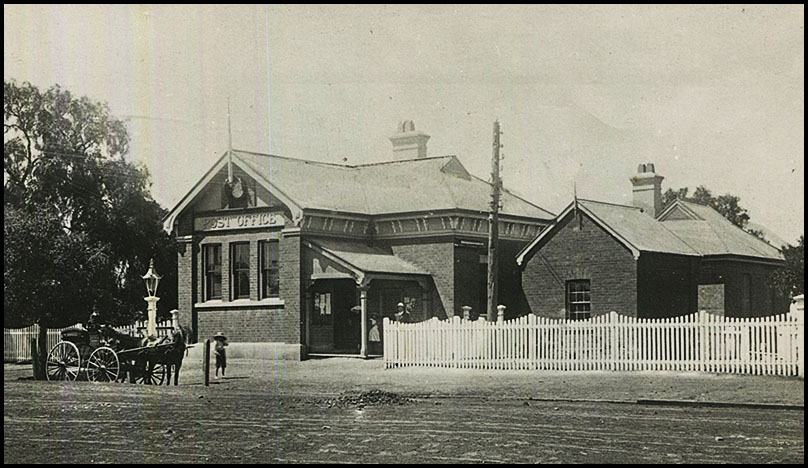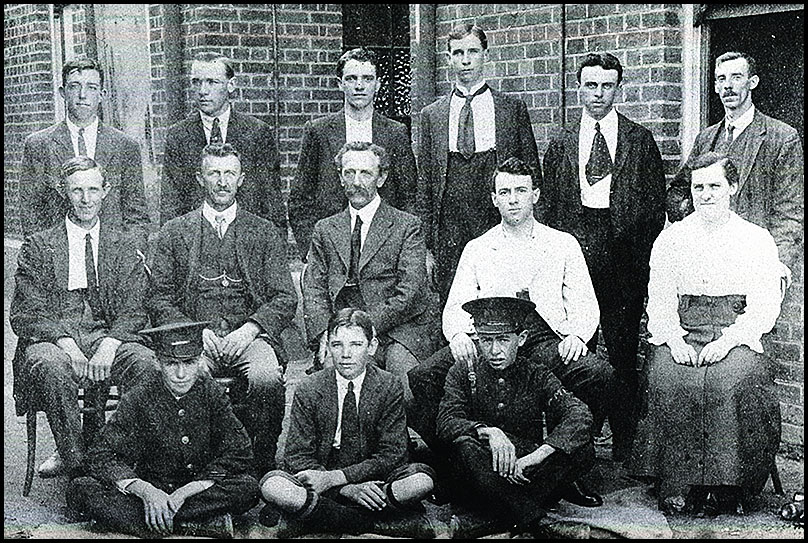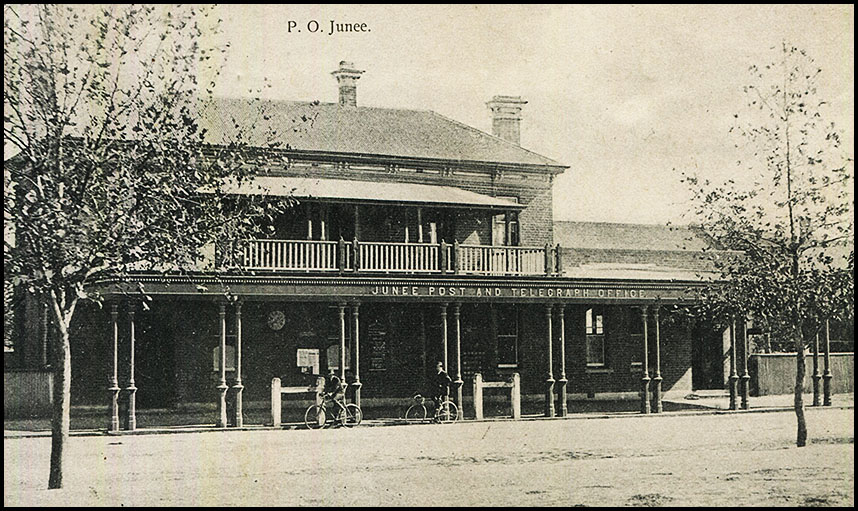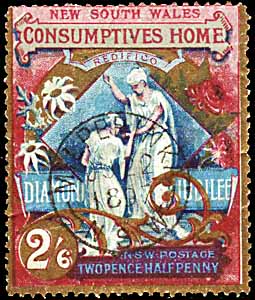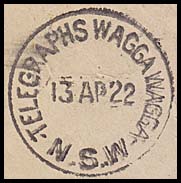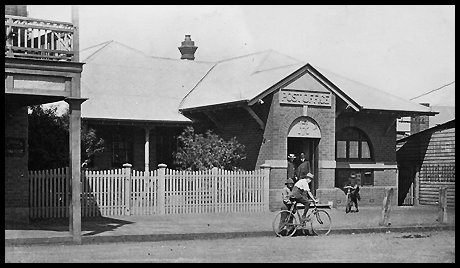Telegraph Offices in the south-west region.
.
- Home, index, site details
- Australia 1901-1988
- New South Wales
- Queensland
- South Australia
- Tasmania
- Victoria
- Western Australia
- International
- Special aspects
The following stations were included on the South-West lines. Some Offices listed were also on the other lines but are also included here when there was an overlap between lines.
| Albury | Balranald | Barmedman | |||
| Urana | Wagga Wagga |
The Yass Telegraph Office was part of the first line to Victoria. Details are therefore included elsewhere.
Telegraph Offices in this region which created the first line to South Australia from New South Wales included Deniliquin, Moulamein, Balranald, Euston and Wentworth.
Public wharves were established by proclamation on 13 April 1872 along the river at Corowa, Mulwala, Tucumwal, Moama, Swan Hill, Euston and Wentworth. These establishments reflect the economic activity which was being generated in the area and so the increased need for telegraphic communications.
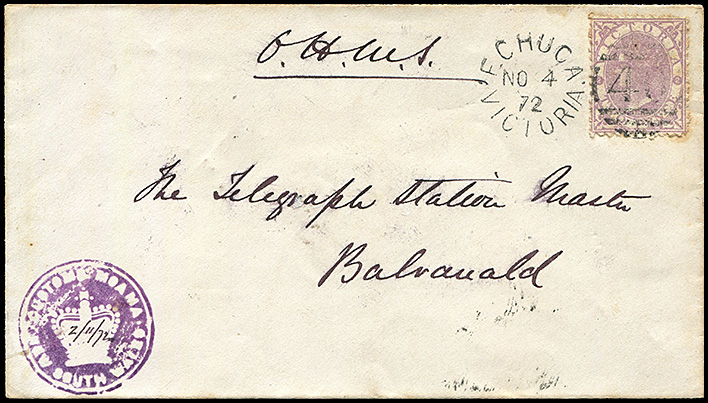 |
Echuca to Balranald 4 November 1872. OHMS cover addressed to the Telegraph Station Master. Has a 2d dull lilac mauve De La Rue design. Cover had crossed the Murray River from Moama to Echuca on 2 November and passed the Customs inspection as shown by the NSW intaglion Crown hand stamp. Very rare. Corinphila May 2018 Lot 3464. |
|
A Telegraph Office was opened at the Railway Station on 15 April 1878. The Post Office, which had opened on 1 December 1875, was moved to the Railway Station on 6 July 1878. As a semi-official office, all parts were remoned from the Railway Station on 1 December 1909. The Wodonga and Towong Sentinel of 10 October 1885 reported the following: "Mr G. A. Sala, in one of his descriptive articles, asserts that he saw Sydney in a dream. If the Governor, or any other exalted official, should chance to visit Bethanga and desire to inspect the Government offices and institutions, it would be well that he, like our late distinguished visitor, should see them in a dream. Viewed through such a medium what he would perceive would naturally differ from the reality ... The Post Office, also a Government building, was as creditable to the representatives of the district as the other erections His Excellency was called upon to admire. The Telegraph Office, situated in the same building, also resounded merrily with the "click" of the instrument and His Excellency took advantage of the occasion to wire to Yackandandah that he intended going to Wodonga instead of visiting that town. But remember all this was in a dream. In reality, the State school is held in a church which costs the Education Department more in rent than would suffice for a decent edifice. The majesty of the law displays itself in a private rented building and so also with the mails. As for Telegraph Office, much as it is required, and notwithstanding that the wires almost pass the place, alas there is none. Indeed the only permanent Government institution is the cemetery. The Bethanga people have reason to complain. They have in many cases made their homes in the mountain township, and should be adequately provided with proper Government buildings. Should the authorities feel doubts as to the permanency of the place, it is quite possible to erect buildings of a good and sufficient but temporary character. It is not at all fair to Bethanga that its population should be put off with the inferior rented structures now evidently considered good enough for the residents".
|
| Berrigan.
The Telegraph Office opened on 2 November 1891. |
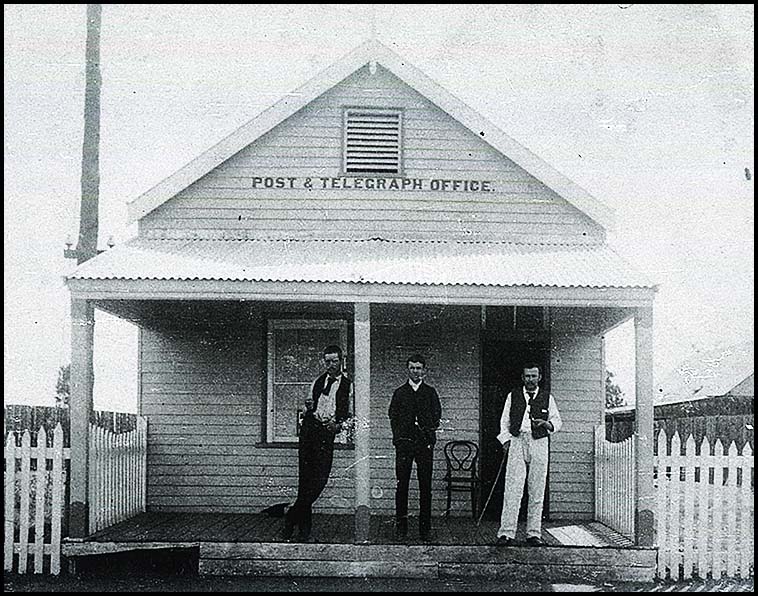 This photo was taken on the day of opening of the new P&T Office or very soon after. |
|
A Post Office opened on 7 March 1861, closed on 30 September 1865 and then reopened on 7 March 1866. The Telegraph Office opened on 1 July 1878 and then combined with the Post Office on 1 November 1878. |
|
| Condobolin.
The Telegraph Office was opened in 1878 and merged with the Post Office on 12 August 1878. The Post Office had been opened on 1 July 1858. Condobolin is the border of the North Central and South West regions but its position along the extension of the Bathurst-Forbes line classifies it as South West for these purposes. Three formats were used for date stamps for the Telegraph Office. |
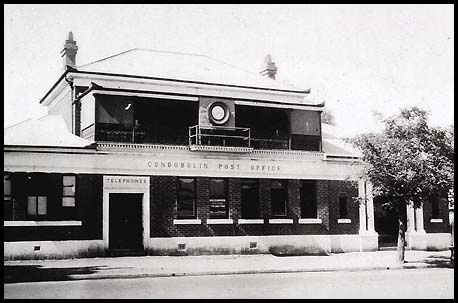 |
|
|
|
|
|
Used on AA-DO-3C. |
|
|
22 August 1980. | |
| Cootamundra.
The Post & Telegraph Office at Cootamundra was opened on 1 July 1877 on which date it changed name from CORAMUNDRA. At that office, a Telegraph Office had been opened on 31 May 1875 and it had combined with the Post Office on 18 December 1876.
|
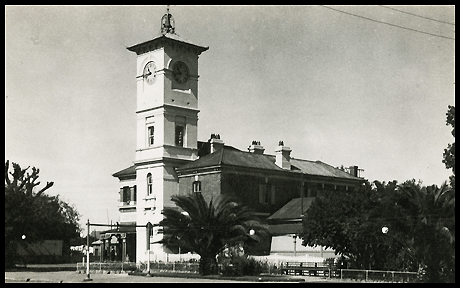 |
||
A steel circular TELEGRAPHS COOTAMUNDRA date stamp (SC1 - T) was used for telegraphic related work:
|
| Corowa.
Corowa is located on the N.S.W. bank of the Murray River on the opposite side to Wahgunyah in Victoria. The Telegraph Office opened 21 January 1873 and combined with the Post Office on 1 September 1873 (TO BE CONFIRMED). The Post Office had opened on 1 January 1861. Corowa was one of the "border towns" - with Wahgunyah - and so had an ambiguous position for the calculation of cost for telegrams. The difficulty was emphasised with rates set for under 15 miles. This ambiguity was not resolved until 1939. |
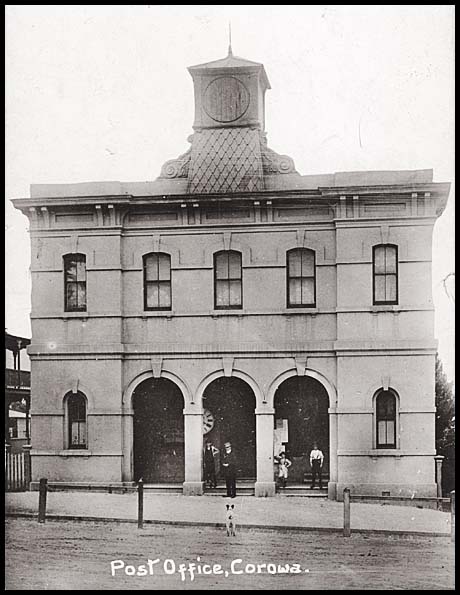 Corowa P&T Office with spire but before clock at top installed. |
|
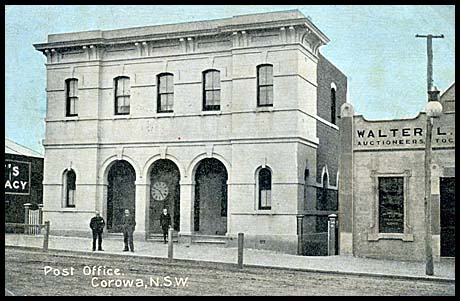 Corowa P&T Office about 1900. Spire not yet constructed. |
||
The North Eastern Ensign reported: "The telegraph operator at Corowa, Mr.T. L. Miller, has been arrested on a charge of embezzling a sum of £15 15s 9d of public moneys and forwarded under police escort to Sydney. This official, who was expected to be honest and maintain the position of a gentleman, only received £100 per annum. It is not long since an operator was transferred to the district, but the order was countermanded in consequence of the youing man having but a Flemish account of his receipts to give his successor". |
||
| Deniliquin.
The first Telegraph Office was opened by a private company together with the Telegraph Office at Moama on 24 March 1859. See the full story elsewhere. The second Telegraph Office opened on 1 August 1861 and merged with the Post Office on 1 January 1870. The two offices then separated on 1 August 1875 before recombining again on 29 June 1901. Tenders for called in the Gazette for the erection of a Telegraph and Post Office at Deniliquin in July 1862 and again 13 March 1863.
|
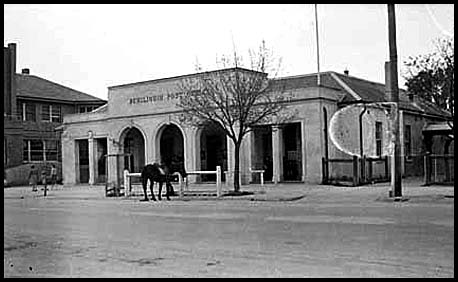 Deniliquin P&T Office taken about 1946. |
A TELEGRAPHS DENILIQUIN date stamp (SC1-T) was used at the Office:
|
 22 October 1946. Used on AW-DO-10 (43). |
| The usual Deniliquin postal date stamp was also used on telegrams. | 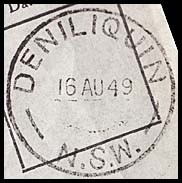 16 August 1949. Used on a Telegraphic Money Order |
| Euston.
The Telegraph Office was opened on 26 April 1867. It merged with the Post Office on 1 January 1870. |
| Hay.
The Telegraph Office opened on 7 May 1864 under the supervision of Mr. Middleton. It combined with the Post Office on 23 December 1870. The Post Office had been opened as Lang's Crossing Place on 1 April 1859. The town was renamed Hay in October 1859 and, on 22 February 1861, the Post Office also had a name change. The present Post Office is on the site of the former goal built in 1860. |
||
|
||
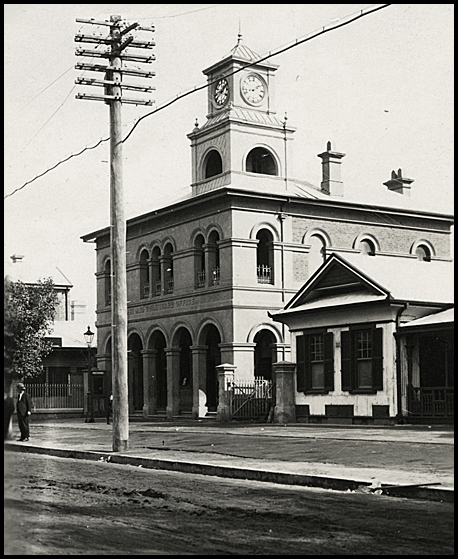 |
(Above): Hay Post & Telegraph Office with the Department of Lands building to the right. |
|
| Even before the telegraph line had been completed, the financial benefits were being anticipated. For example, the Argus of 3 July 1863 carried an advertisement for the sale of the Argyle Hotel which noted, in addition to the facilities, "its close proximity to the Murrumbidgee and to the terminus of the Deniliquin and Hay Telegraph Line renders it a most desirable investment, it being the only hotel in Hay suited to doing a first- class trade".
On 14 September 1872, the Australian Town and Country Journal, in a story about Hay noted:
|
||
|
The Telegraph Office opened on 26 June 1878 and was merged with the Post Office on 10 May 1880. |
| Ivanhoe.
The Telegraph Office opened on 5 February1883 and merged with the Post Office on 15 May 1883. The Post Office had opened on 1 January 1874. |
| Jerilderie.
The Telegraph Office opened on 4 May 1866. It changed name from Jereelderie in 1890. The Kelly Gang held-up the Jerilderie branch of the Bank of New South Wales in February 1879 and, while in town, inflicted considerable damage to the wires, insulators and the telegraph poles. See elsewhere for the story. |
|
|
|
|
|
|
A Post Office opened at Junee on 1 May 1862, It closed on 2 September 1878 only to open the next day as a Receiving Office. It changed name to Old Junee on 16 July 1881 and became the Post Office at the Railway Station. From 19 June 1909, it also acted as a telephone station with telegraph responsibilities. On 1 May 1913, it became a Post and Telegraph Office and was removed from the Railway Station. On 6 July 1878, a Telegraph Office and Receicing Office were opened at the Railway Station. That Office changed its name to Junee Junction on 16 July 1881 and then to Junee Post and Telegraph Office on 1 November 1893. |
|
|
Close to the border with Victoria, a Post Office was opened at Lalalty on the change of name from Naranghi on 1 August 1900. That office was closed on 31 March 1910. On 24 May 1922, a Telegraph/Telephone Office was opened followed later by a Post Office which operated from 1 January 1927 to 1 August 1930. The joint telegraph/telephone office continued to operate until it was destroyed by fire on 13 February 1939. It was closed on 10 March 1941. It then operated until 7 May 1957 as a Rural Automatic (Telephone) Exchange.
|
||
The telegraph section of the joint office was issued with a very unusual date stamp for use with telegrams.
|
 12 April 1939. |
|
| Moama.
Moama is directly across the Murray from Echuca. It had been the Victorian Post Office of Maiden's Punt from 1848 to 1855 when it was transferred to NSW. The Post Office changed name to Moama on 1 January 1858. Unfortunately the Post Office was destroyed by fire in December 1861. The first Telegraph Office opened in Moama on 24 March 1859 together with the Telegraph Office at Deniliquin. The line from Echuca and the Telegraph Station were organised and paid for by the people of Moama and Deniliquin as a private enterprise. See the full story elsewhere. The "State Owned" Telegraph Office was opened at Moama in May, 1862 by William Camper when he was transferred from Kiama. In contrast, the Echuca Telegraph Office on the other side of the Murray River had opened in December 1858. Mr Camper remained in charge at Moama until March, 1867 when he accompanied Superintendent Cracknell to Wentworth to establish a border repeating office linking up the South Australian, Victorian and New South Wales lines. |
The Bendigo Advertiser of 9 June 1859 reported: "MOAMA
The Riverine Herald of 11 November 1879 reported:
|
| Narrandera.
The Telegraph Office opened at the Post Office on 27 July 1876 and the two offices merged on 1 September 1876. The Post Office had originally opened on 1 October 1861 with a change of name from Gillinbah. The second person to be appointed to the Narrandera P&T Office was the telegraph messenger on 27 November 1878. An excellent history of Narrandera and the surrounding area is given elsewhere. |
||
A rubber circular Telegraph Office date stamp (RC3 - TO) was provided for use with Telegrams.
|
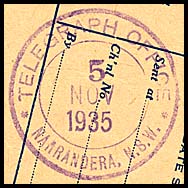 5 November 1935. |
|
|
Tocumwal is just on the border with Victoria. A Telegraph Office operated at the Railway Station from 1 May 1937 to 31 August 1967. |
|
A Telegraph Office was opened at Urana on 18 August 1861 about 7 months after the Post Office had opened. The two Offices were combined on 8 November 1869. It is prsumed that there may not have been any dedicated building for the combined operation because The Ovens and Murray Advertiser of 15 September 1877 noted "Some annoyance is expressed at the delay of starting the Post and Telegraph office (at Urana) and the Court House, the contract of which was let to Mr Hardy of Wagga Wagga; but from what can be ascertained, there is some dispute between the contractor and the Government about the details of the specifications. It is to be hoped that the two offices will soon be in course of erection as the present edifices are unfit for the business transacted in them". |
| Wagga Wagga.
The Telegraph Office was opened on 10 June 1861 and merged with the Post Office in 1869. The Post Office had opened on 1 January 1849.
|
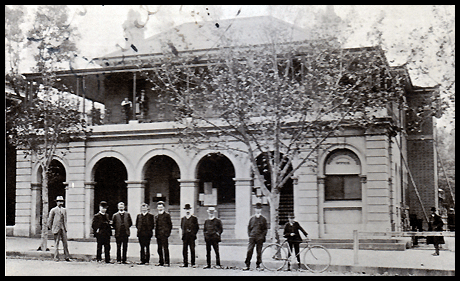 |
During the floods of October 1867, frequent telegrams were sent from Gundagai to Wagga Wagga informing them of river heights. To remember how important the telegraph was in times of emergence, extracts related to the telegraph in a major flood are included: The Sydney Morning Herald of 16 October 1867 reported "by telegram from Gundagai, it was then known the flood had reached the level of the June flood, the coming inundation was seen to be inevitable. During Monday the waters still rose though not so rapidly as had been anticipated and that night they flowed over the bank and found their way into the lower portions of Fitzmaurice Street. On Tuesday morning, the occupants of the Prince of Wales and Squatters' Hotels and many other buildings were flooded out. The Bank of New South Wales was surrounded and the highest floors upon the premises covered several inches deep ... |
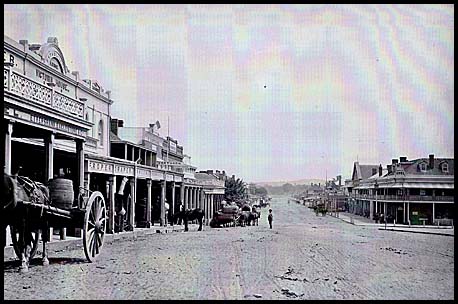 Fitzmaurice Street, Wagga Wagga about 1880. |
The Post Office was swamped early in the day, and the letters and papers were hastily removed to a room in the Pastoral Hotel which was constituted as a temporary Post Office for the occasion. In the afternoon telegrams were received from Gundagai conveying the welcome intelligence that the river had fallen at that town and the apprehensions of the people were, in a measure, relieved. But as the waters still crept steadily up the gauges, which each anxious householder had placed opposite his door, it was impossible not to experience some feelings of disquietude and, when night closed in, there were few who thought of retiring to their beds. The whole river valley was then transformed into a sea of water, flowing through and against this, trees which impeded its course with a heavy ceaseless roar which the stillness of the night air rendered doubly impressive to the groups upon the footpaths who were patiently watching the rising flood. A little after midnight, to the relief of all, the rising ceased, and the waters soon after began gradually to abate, having attained a greater height by four inches than last June ... below the town the river was four miles wide on Tuesday ... The Kyamba Creek Bridge was covered above the hand-railing but, in spite of the current and the insecurity of the structure, the mailman succeeded in crossing it, a plucky act which places in striking contrast the conduct of the contractors on the main line between Gundagi and Tarcutta, who have coolly detained our mails whenever they have deemed it inconvenient to travel ... The police boat has rotted away and is now comfortably reposing in the bed of the river. Are the police to be ever again supplied with another or will it be necessary to wait until valuable lives have been sacrificed before the urgency of the want will be admitted? We stated last week that it was impossible to ascertain the correct level of the river at Gundagai owing to the want of a proper gauge. We have since been informed that a gauge has been fixed there for some time and that a daily record of the river level is kept. The information thus gained will no doubt prove extremely useful hereafter but, for people residing here and lower down the river, the gauge, at the times it is most wanted, is never likely to be of much service as it is fixed on the south bank of the river while the telegraph office is situated on the north. In times of flood communication between the two, is sure to be irregular and uncertain".
For a reference to the Telegraph Messenger in 1875, see elsewhere. |
|
On 29 April 1887, notice was given in the Gazette of the resumption of a portion of land in the parish of South Wagga Wagga, town of Wagga Wagga, in connection with the erection of a Post and Telegraph office. In July 1940, a new Telephone Exchange was opened in Wagga incorporating the most modern telegraphic equipment. From then, telegram messages could be automatically repeated from outlying centres, cities and towns direct to Sydney without having to be repeated by telegraphists.A Telegraph Office was opened as Wagga Wagga Rail Telegraph Office on 20 May 1895. It closed on 31 August 1948. |
|
| Two formats of a TELEGRAPHS WAGGA WAGGA date stamp were used. | ||
|
Used on an internal memo. |
Used on Press telegram AE-DP-2 |
|
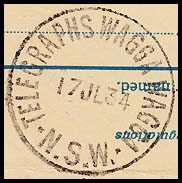 17 July 1934. |
|
The usual Wagga Wagga postal date stamp was also used on telegrams. This format changed over the years.
|
Used on NI-DO-1. |
||
